A mature hairline is the “V” shaped position your hairline naturally ages to between the ages of 17 to 27. A mature hairline is sometimes called a widow’s peak, and it is characterised by your hairline moving evenly across the hairline and temples, and it can start to develop at the age of 17. A hairline tends to stop maturing between the ages of 25-27.
A receding hairline is when someone loses hair beyond their maturing hairline and it is noticeable with active hair shedding and hair thinning. This often makes the hairline uneven, creating an “M” shaped or a deeper uneven hairline. A receding hairline is often due to male pattern baldness- a condition many men suffer from at some point in their life.
It’s normal for a man’s hairline to recede to some degree after adolescence. However, it is important to discern whether this is due to a maturing hairline or one associated with hair loss. Part of my consultation and investigation will always involve assessing whether my patient’s hairline is maturing or receding secondary to hair loss.
Dr Roshan Vara, Director and Hair Transplant Surgeon
What’s the Difference Between a Mature Hairline and a Receding Hairline?
A mature hairline is a natural part of ageing, where the hairline recedes slightly, typically by 1–2 cm. This forms a “V” shaped or widow’s peak appearance and typically starts between ages 17 to 27. A mature hairline progresses evenly across the forehead and temples, stabilising with age.
In contrast, a receding hairline is a sign of male pattern baldness, where the hairline moves further back in an uneven pattern, often forming an “M” shape. This is characterised by thinning, active shedding, and progressive loss beyond the typical maturation zone.
Mature Hairline
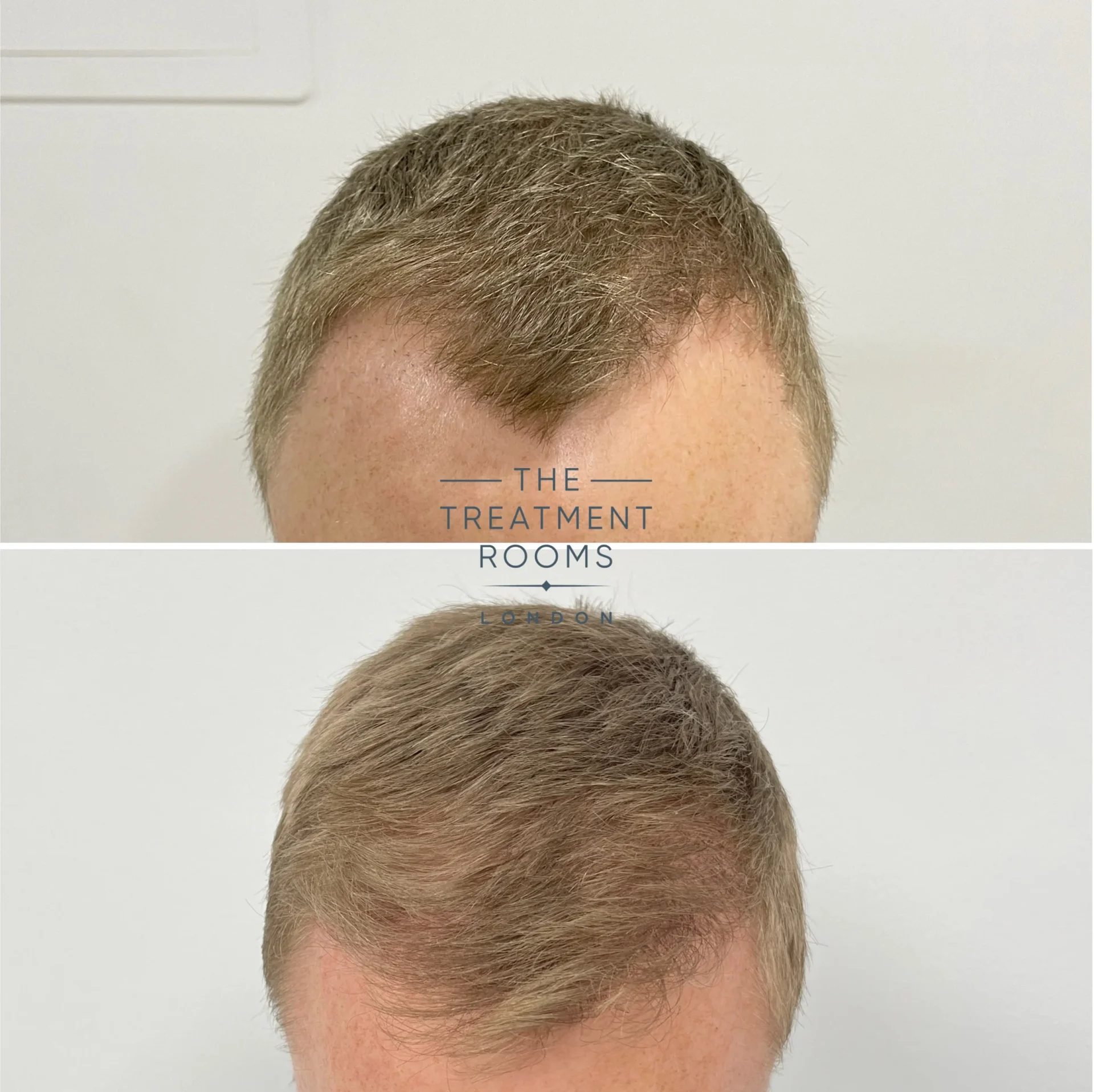
Receding Hairline
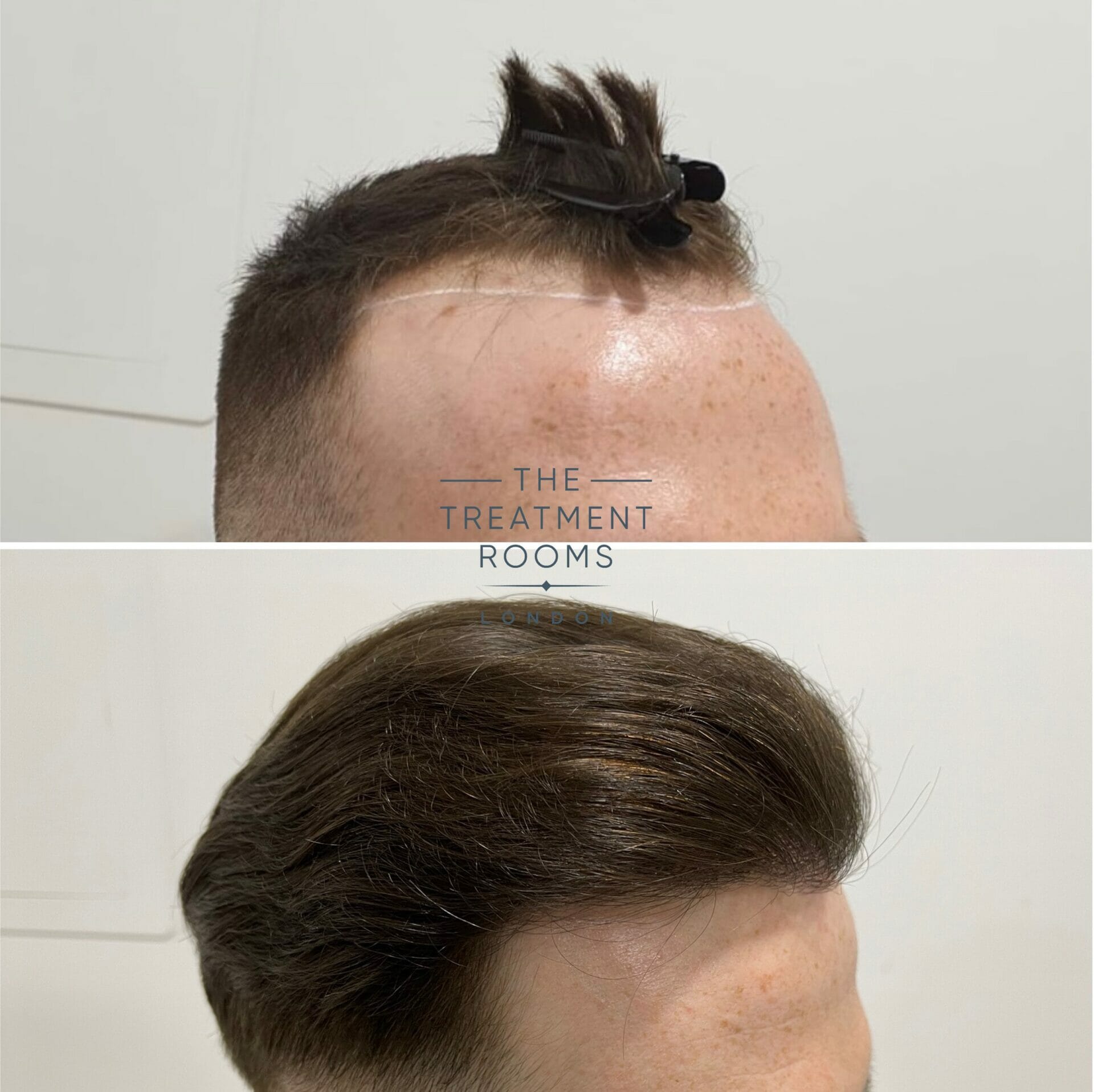
The differences between a mature and a receding hairline are summarised in the table below:
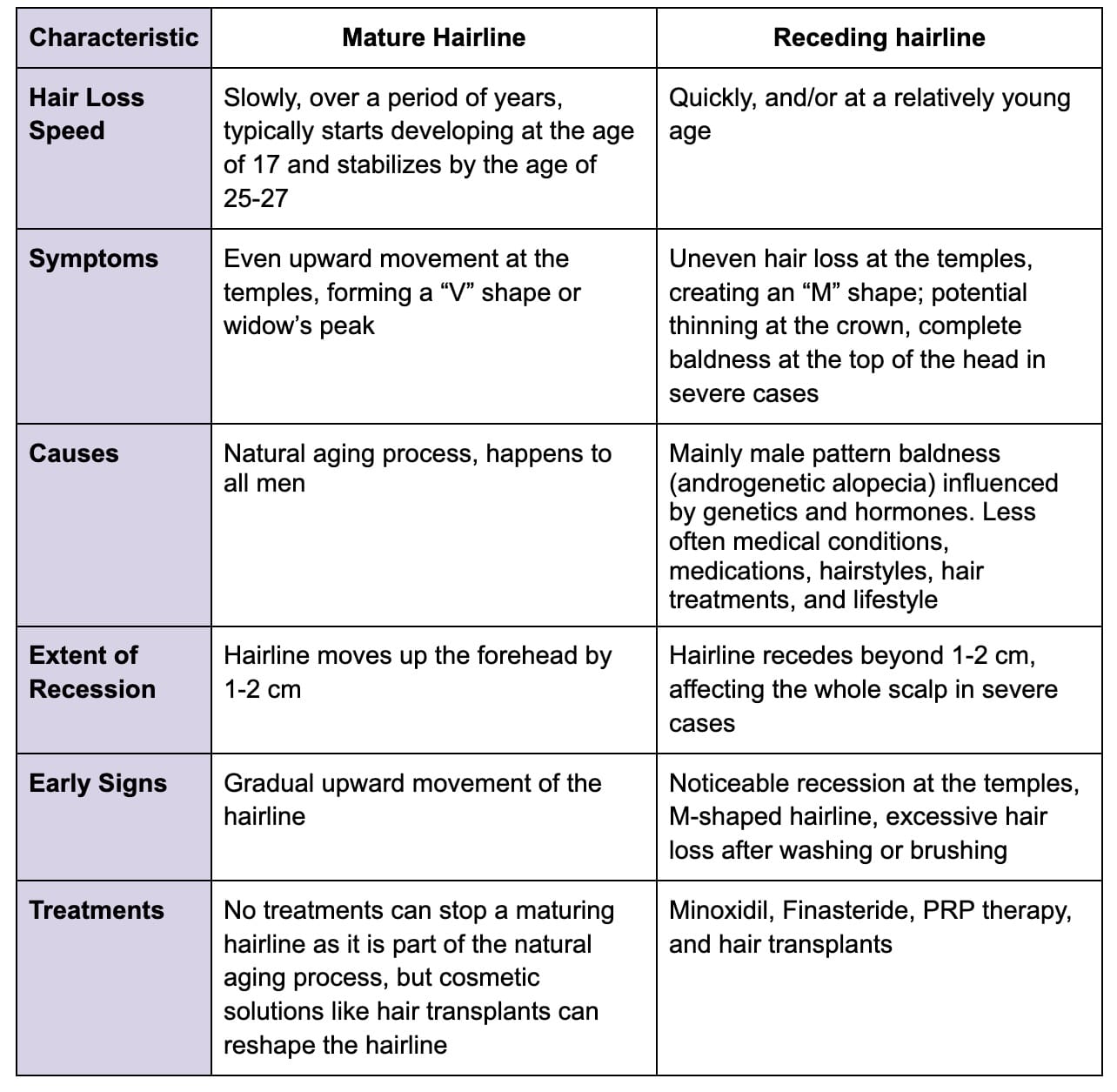
In this article, we’ll look at the difference between a mature hairline and a receding hairline.
How to Know If Your Hairline Is Maturing or Receding
To understand whether your hairline is maturing or receding, you may want to explore the following:
- Take a look at your family history- if members of the family have a slightly uneven hairline but with no further hair loss, it is likely you are seeing a maturing of your hairline which should stop at the age of 27
- Take some pictures of your hairline between the ages of 20-27- you may see subtle changes in the position that may be in keeping with hair loss or a maturing hairline
Understanding Changes In Your Hairline
Hairline changes are a natural part of aging, and it’s essential to understand the differences between a maturing hairline and a receding hairline. A maturing hairline is a normal part of aging, where the hairline recedes slightly, typically up to an inch, forming a more defined and less rounded appearance often seen as a widow’s peak or “V-shape”.
On the other hand, a receding hairline is a sign of male pattern baldness, where the hairline recedes significantly, often forming an “M” shape. Recognising these differences can help you determine whether your hairline changes are a natural part of aging or a sign of male pattern baldness.
What is a mature hairline?
At the age of 17, it is natural for the juvenile hairline to move upwards at the temples. The juvenile hairline is often flatter and more oval in shape. However, as you age, this hairline will start to move and this process is known as a maturing hairline.
Signs of a maturing hairline
One of the key characteristics of a maturing hairline is the areas in which the hairline changes. A maturing hairline typically moves evenly along its original line. With a maturing hairline, the hair will retreat by 1cm to 2cm upwards from its original position experienced as a teenager. This often leaves patient with a “V” shaped hairline as depicted below.

It is common for my patients to ask me whether they are receding or if their hairline is just maturing. It’s a really important question as it will determine whether we opt for surgery or not. Ultimately it is important to be evaluated in person to assess whether you are just undergoing maturation of your hairline or if you are losing hair and receding
Dr Fernando, Hair Transplant Surgeon and Director at The Treatment Rooms London
What is a receding hairline?
In contrast to a maturing hairline, a receding hairline will retreat unevenly, with some parts of the hairline receding significantly faster than others. Characteristically, a receding hairline will retreat more in the temple area, creating the pattern of an M-shape. The pattern deepens over time, as the temple hair loss becomes more severe and the entire hairline eventually recedes. This can be followed by thinning at the crown, and in some cases, complete baldness at the top of the head. The stages of severity for a receding hairline is classified by the Norwood Scale.
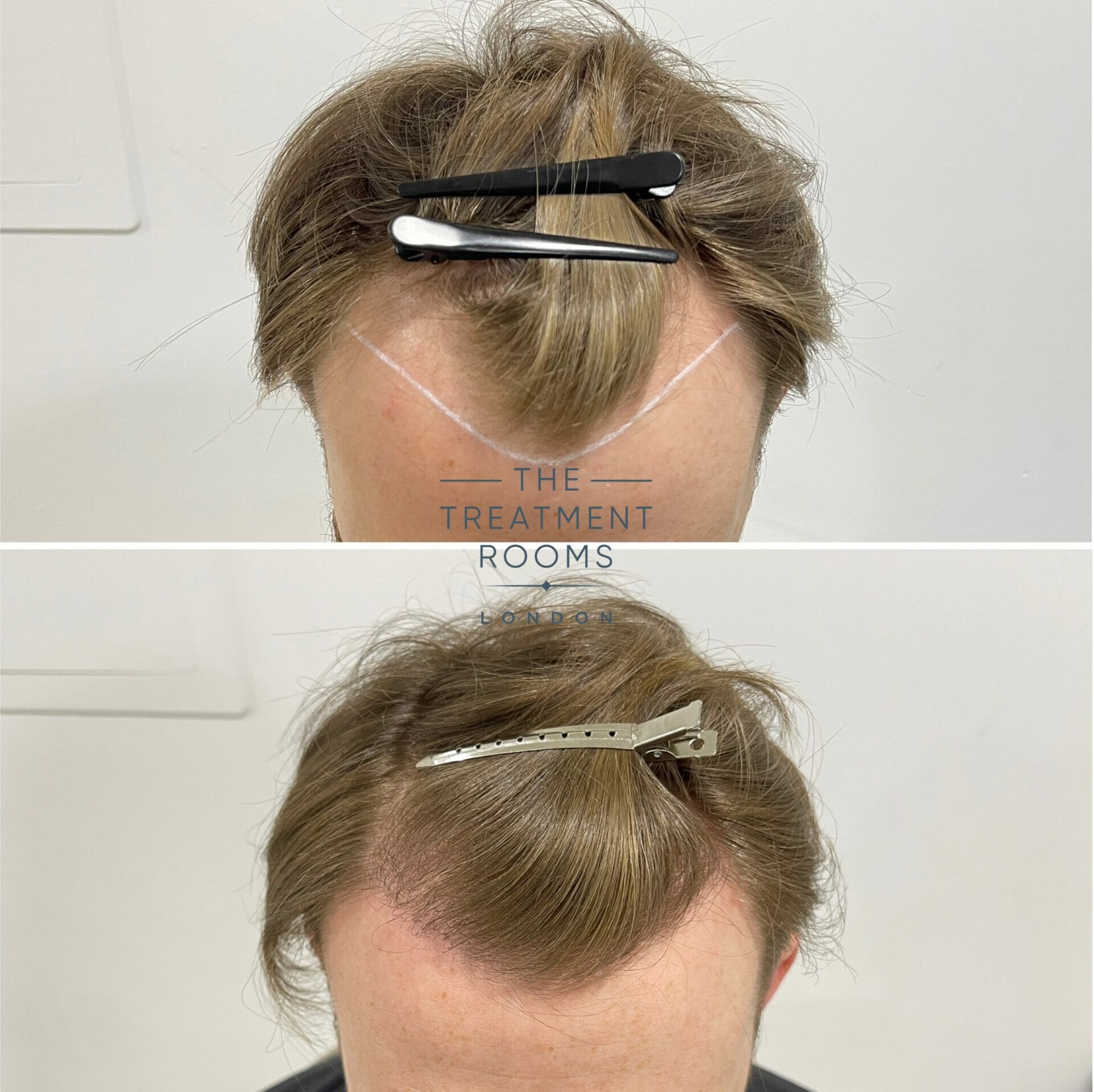
Signs of a receding hairline
With a receding hairline, the hair loss is usually moving several centimetres upwards, leading to a more exposed forehead.
To complicate matters further, a receding hairline can occur at the same time as your hairline matures from the age of 17. As hairlines mature, they undergo a slight recession, which is a natural part of the aging process. This will cause your hairline to move higher at a quicker rate than someone who isn’t losing hair. This can result in very young patients being concerned about hair loss. It’s important to address these concerns early as there are a number of treatments that can help.
Typically a receding hairline is a form of male pattern baldness (androgenetic alopecia), which affects around 50% of men over the age of 50 in the UK and coincides with active hair shedding.
What causes receding hairline?
Male pattern hair loss is the main cause of a receding hairline. This condition is triggered by a combination of genetics and hormones. Studies have shown that in around 80 percent of cases, male pattern baldness is hereditary.
Androgens, the male hormones, have a role in shrinking hair follicles. Research shows that some men inherit a sensitivity to the androgens that cause baldness. Hair follicles at the temples and crown are understood to be more sensitive to these androgens, which partly explains the receding hairline pattern.
Medical conditions, medications, hairstyles, hair treatments, and lifestyle could also play a contributory role in male pattern baldness.
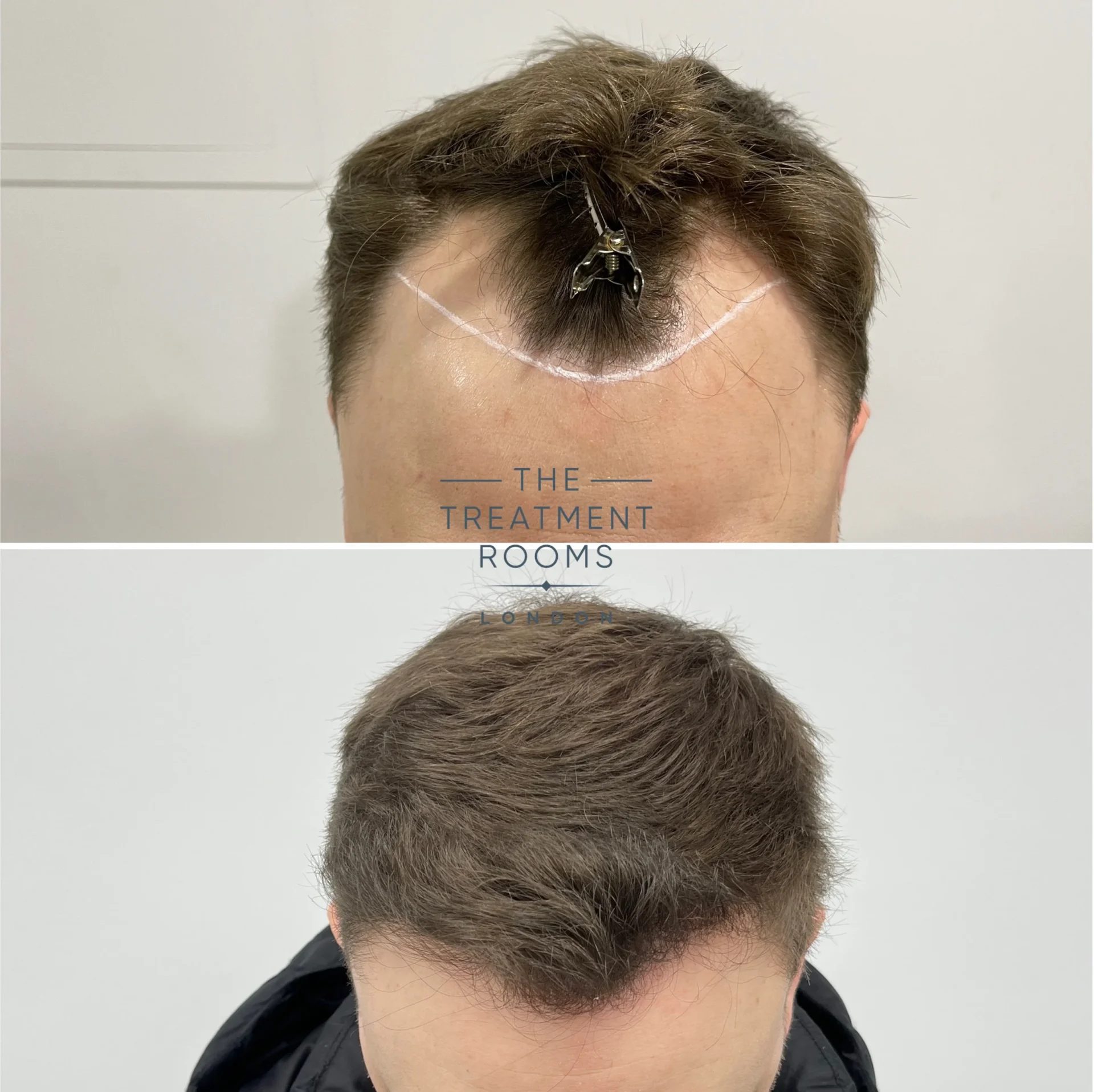
Mature hairline vs receding hairline differences
While a mature hairline can be seen as a natural part of getting older, a receding hairline, although common, is usually passed down generations and is caused by dihydrotestosterone (DHT).
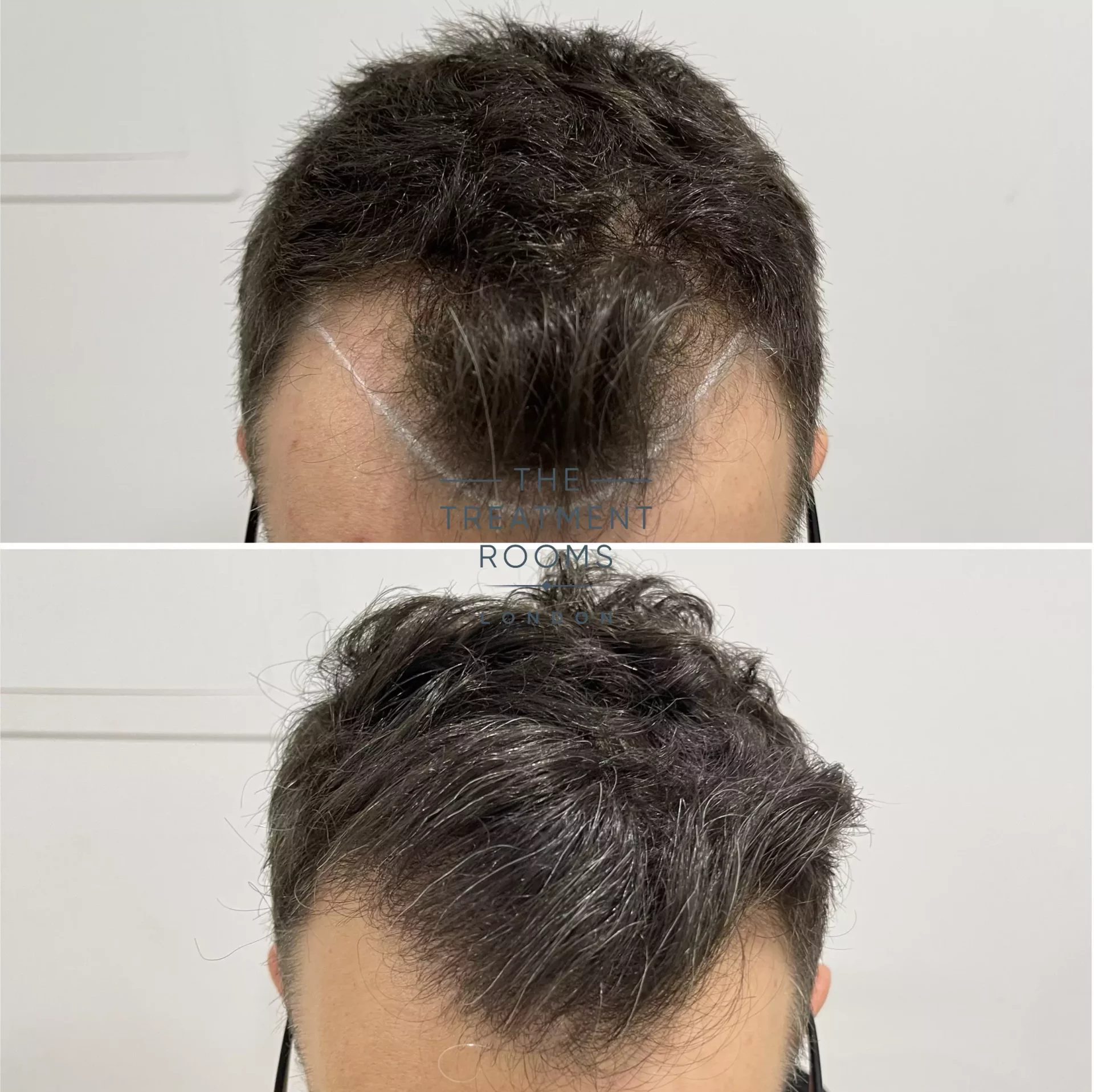
The two main differences between a mature hairline and a receding hairline are the extent of the recession and the pattern.
A maturing hairline will:
- Cause the hairline to move up the forehead by 1-2cm
- Tend to change the hairline evenly across the forehead
A receding hairline will:
- Make the hairline move up the forehead and beyond, sometimes involving the whole scalp
- Tend to change the hairline unevenly across the forehead- leading to a characteristic M-shaped hairline.
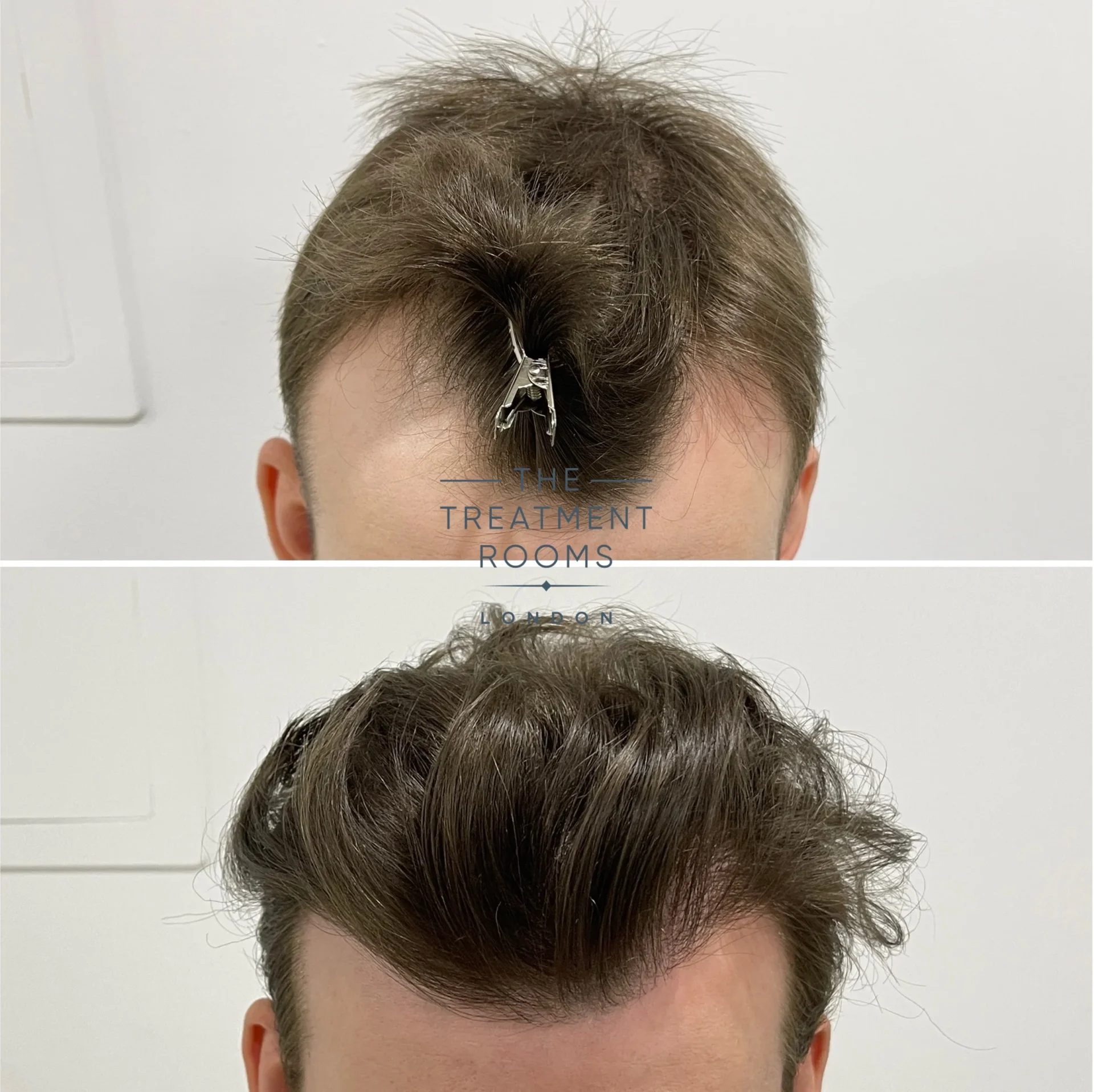
Early signs of receding hairline
So, how can you spot the early signs of a receding hairline? Male pattern baldness occurs over years, but you can identify it, and take action to prevent it.
The most recognisable sign, as you might expect, is a change in your hairline. Even if you don’t notice this when looking in the mirror, you may see it when comparing recent photographs with those from a few years ago. If you see a significant recession of hair at the temples, and an M-shape beginning to form, this suggests you have a receding hairline. You might also notice excessive hair loss or thinning hair after washing or brushing your hair.
How to stop maturing hairline
You can’t stop a maturing hairline. It is the result of your body’s natural ageing process. You can straighten your hairline with a hair transplant to change the shape of your hairline if you don’t like how it has matured.

Embracing a maturing hairline
As there isn’t much you can do to prevent your hairline maturing, it is prudent to understand how you can embrace one. Many celebrities like Harry Styles have a matured hairline, creating a “V” shape in the middle. They often style their hair upwards to showcase the position or they style their hair from one side to the other to hide a side that has matured more than the other. Most often, patients don’t require surgery to correct an uneven, matured hairline but when they do, the procedure can make a life changing difference.
Treatment Options If Your Hairline Is Receding
As male pattern baldness is largely a hereditary condition, there is no way to prevent a receding hairline from occurring initially. However, several treatments can slow down a receding hairline, and there are ways that you can reverse it.
Receding hairline treatment
There is a range of non-surgical hair loss treatments that you should consider before undergoing a procedure to reverse hair loss. These hair loss treatments include:
- Minoxidil – coming in a foam or other topical solution, minoxidil can support hair regrowth. This medication has been shown to be beneficial in treating hair loss. It can result in healthier, stronger hair.
- Finasteride – this treatment for male pattern baldness is a 5-alpha-reductase enzyme blocker. The 5-alpha-reductase enzyme produces dihydrotestosterone (DHT)- a hormone that causes male hair loss. Taking finasteride can slow your rate of hair loss and support hair regrowth.
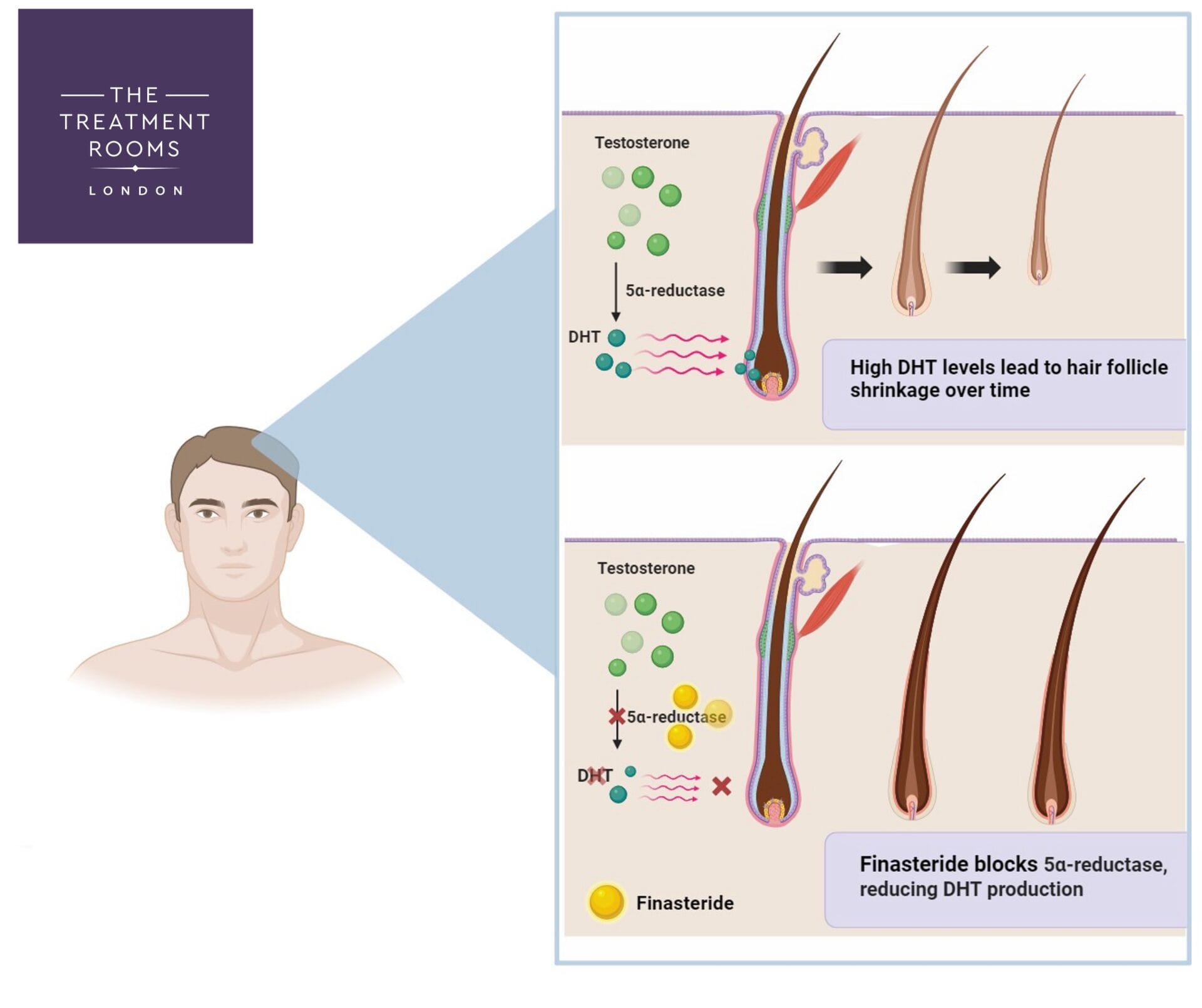
- PRP hair treatment – platelet-rich plasma (PRP) therapy can restore hair and encourage healing. It is a regenerative medicine that is administered via an injection into the scalp. For the best results, several PRP sessions would usually be scheduled across three months.
Early action for a receding hairline vs waiting
Depending on how much your hairline impacts your well-being will determine whether you want to address the issue early or wait for it to get worse. This is an individual choice and our Surgeons are happy to formulate a plan that works for you. In the first instance, our Surgeons are likely to advice addressing your concerns with medications before exploring hair transplant surgery.
Hair transplant options for a mature and receding hairline
Hair transplants are the most effective receding hairline treatment available. The procedure is able to effectively restore hair that was once lost, whether that’s at your hairline or your crown and results can be permanent. But how does a hair transplant work? It takes a full year for patients to grow their outcome and a rough timeline of growth can be seen here: hair transplant timeline.
There are two main types of hairline transplants – FUE hair transplants and FUT hair transplants:
- FUE – the FUE technique takes individual follicles by extracting them from the back of the scalp, using tiny punches. The hair follicles are then carefully placed gently in ready-made holes at the recipient area.
- FUT – the FUT technique takes a strip from the donor area at the back of the scalp. After the donor area is stitched up, this strip is split into smaller sections with a surgical tool and implanted in the recipient site.
To learn more about the hair transplant process, why not visit our patient journey page for more information. You can also see a number of hair transplant patients in our dedicated gallery: Hair Transplant Before and After.

Frequently Asked Questions- Mature vs Receding Hairline
Can a mature hairline turn into baldness?
Yes, a mature hairline can lead to further hair loss over time and this is dependent on family history, genetics and other health conditions you may suffer from across your life.
How long does a mature hairline take to develop?
A mature hairline can develop as early as 17 years old. It often starts at the age of 20 and develops until the age of 27.
Is a mature hairline attractive?
Having a mature hairline can be seen as attractive as it gives someone a characteristic that is unique and distinct to them.
Can I prevent a receding hairline?
You can prevent a receding hairline by considering medications like Finasteride and Minoxidil- both are licensed and proven to help prevent hair loss in men. Women can consider taking Minoxidil to help with their receding hairline.
Will hair transplants restore a mature hairline?
Hair transplant surgery can restore hair in front of a matured hairline to make it appear more even and balanced. The procedure takes 1 day and the recovery takes 5-7 days.
Why Trust Treatment Rooms London for Hairline Advice
At The Treatment Rooms London, our surgeons possess a wealth of experience in performing both FUE and FUT hair transplants, as well as providing non-surgical techniques, giving your hair the best conditions for regrowth. They are experts in being able to provide personalised advice depending on your main concern, with surgery the only option where required. They are one of the best hair transplant surgeons when it comes to the artistic design and planning of restoring a hairline and you can view their work on receding and maturing hairlines in our extensive before and after gallery. You can book a consultation with one of our experienced GMC registered surgeons today to explore your options.
Share:
Authored by
Reviewed by
Book a Consultation
Related Blogs
When Can You Safely Wear a Beanie After a Hair Transplant?
July 3, 2025
Quick Summary Cap Recommendations: Light, breathable caps, such as snapbacks or trucker hats, are advisable if you need…
Castor Oil (Ricino Oil) for Hair Growth: Benefits, Uses & How to Apply for Maximum Results
June 26, 2025
Castor oil, also known as Ricino oil, is extracted from the Castor bean plant (Ricinus communis). During…
What is a Hair Transplant? How it Works, Success Rate & What to Expect
June 23, 2025
Hair transplantation is a cosmetic surgical procedure that restores hair by moving healthy follicles from one part…
John Cena Hair Transplant
May 14, 2025
John Cena, a common household name, is a figure who has effortlessly straddled the worlds of professional…
Kyle Walker Hair Transplant: Before, After, and His New Hairline
May 12, 2025
Kyle Walker is known for his defensive skills at Tottenham Hotspur, Manchester City, and in the England…
Celebrity Hair Transplants: Full Before and After Analysis
May 8, 2025
Elon Musk Hair Transplant Elon Musk, the billionaire behind Tesla and SpaceX, is well-known for his innovations…
Lewis Hamilton Hair Transplant: Before, After, and His New Hairline
May 7, 2025
As a top-class racing driver, Hamilton is used to wearing a race helmet. While this does protect…
James Nesbitt Hair Transplant: Before, After, and His New Hairline
May 6, 2025
James Nesbitt, the Northern Irish actor famed for his role as Adam Williams in the British comedy-drama…
How Many Hair Grafts Do You Need For A FUE Hair Transplant?
May 3, 2025
An Follicular Unit Excision (FUE) or FUT hair transplant are 2 main procedures available to address hair…











